MEKONG DELTA AND RIVER
The Mekong River was named by the Thais. They called it Mae Khong which means ‘Khong River’. Khong is a species of crocodile once believed to have lived in the river. The Mekong River is also called the Mother River of Southeast Asia.
The Mekong River is one of the 12 great rivers of the world. It is the 12th longest river in the world and the seventh longest in Asia. It stretches 2,700 miles from the Tibetan Plateau in China to its mouths in the Mekong Delta of Vietnam. It courses its way from Tibet to China’s Yunnan province, then to Myanmar, then to Thailand, then to Laos, then to Cambodia, then finally to Vietnam. The Mekong is not, however, passable from Tibet to Vietnam. There are rapids near the Cambodian/Laotian border that make the Mekong non-navigable. Still, the Mekong River flows through all of the countries that comprise mainland Southeast Asia as well as China with half of its distance within China. The river links the region both symbolically and physically.
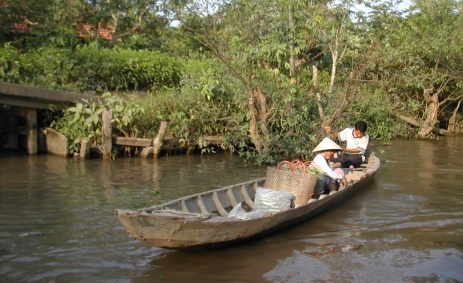
Fishing in the Delta
The Upper Mekong – from Tibet down to the area of the borders of Myanmar, Thailand, and Laos – is relatively clear and fast flowing. The Lower Mekong – from the tri-border area down to Vietnam’s Mekong Delta – is turbid, especially in the rainy season.
Every year the river empties 363 million cubic yards of water in to the South China Sea. As it flows southward, it brings fertile silt to the land along its banks, but particularly to Vietnam’s Mekong Delta. Ninety million people rely on the river for food – mostly for rice production but also for vast amounts of fish. The Cambodians get 80% of their protein from fish in the Mekong.
The Mekong River has some of the richest biodiversity in the world. More than 1,200 fish species have been identified, and it is thought that up to 1,700 may exist. However, many species are in danger.
There are two major environmental concerns on the river that threaten those people living along the river as well as the fauna within the river. One is the building of dams. Another is blasting of rapids. There are currently two dams on the river – both in China. However, China is discussing building as many as twelve more. That and blasting rapids both cause changes that threaten the delicate balance that the river has developed over time. These changes are potentially lethal to the impoverished Cambodians whom rely on the river for their livelihood as well as to many of the species in the river.
An interesting feature of the Mekong River is its annual flooding of Tonle Sap Lake in Cambodia. During the rainy season, as the river floods from upstream, the Tonle Sap increases in size tenfold. Then, as the flow from the north decreases, the Tonle Sap releases water downstream and slowly returns to its smaller size. It acts as a natural reservoir. This annual control is believed to have enabled the rice surplus on which the Angkor Empire was founded, and it sustains the Cambodians today. The Mekong really is the Mother River of Southeast Asia.
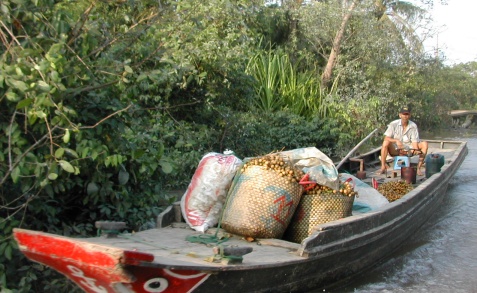
In the Delta – Heading to Market
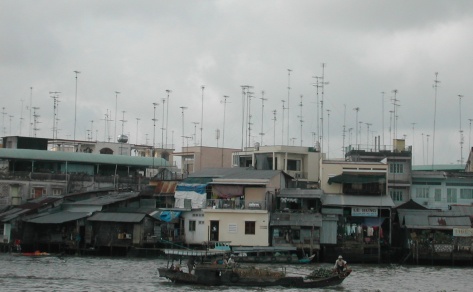
Look at the tv antennae in Cai Be!
It took us about two hours to travel from Saigon westward to My Tho which is where we embarked the RV Mekong Pandaw which would be our home for the next eight days. Although My Tho is considered the ‘hub’ of the Mekong Delta, it is not particularly interesting itself, so we quickly threw off the dock lines and headed for Vinh Long about 27 miles away.
After anchoring in the middle of the river, we left the mothership and boarded small local boats. Our first stop was a brick factory. We didn’t think this would be particularly interesting, but we were wrong. So far, we had found the Vietnamese quite resourceful and industrious. They make do with what they have available, and they do well with it. So they did at the brick factory. We were impressed with the simplicity and resourcefulness of the operation.
We cruised around some of the delta’s smaller waterways to see the lifestyle. It was difficult to imagine the warfare that occurred here. We walked around a highly productive fruit farm and visited a bonsai garden. Nita met, and petted, Tony – a ten foot boa constrictor.
Cai Be is known for its colorful floating market. So we again climbed in to smaller boats and traveled through the market. It was interesting and colorful, but we probably got there too late to see it in full swing. It was more sedate than we expected.
We also visited the French Gothic Cathedral in Cai Be, and we expected it to be packed given that it was Easter Sunday. It was deserted. There was nobody there. Don’t know why.
We visited the An Kiet house which is a former imperial residence. We walked around through their lush fruit orchard and gardens. It was a very peaceful place.
Then we cruised to another village where we watched them make various rice products including rice paper, puffed rice cakes (Nita loves these and always wondered how they were made), and a dreadful tasting rice wine. They also made a yummy coconut candy.
But we needed to head north, so we returned to the mothership and weighed anchor. We went 76 miles north and anchored in the Tan Chau Canal near Chau Doc.
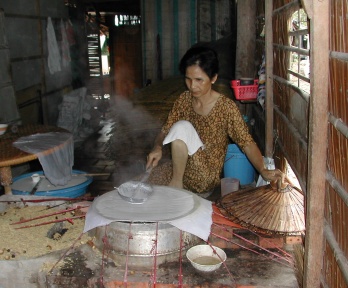
Making rice paper in Cai Be
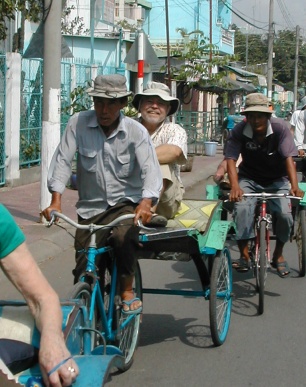
Trishaw Taxi in Chau Doc
We left the mothership in Tan Chau Canal and boarded another boat to take us in to Chau Doc. We toured around the town of Chau Doc by rickshaw. These were individual rickshaws powered by a bicycle. We were surprised that Chau Doc was as big as it was. It has a large commercial area, and it appeared that most anything one needed could be found there.
After touring the town, we got in smaller boats and went to a fish farm. This was a floating house with nets underneath, and lift-out boards made the netted area accessible. They farm what they call a ‘whiskerless cat fish’; however, it is nothing like what we call catfish in the US. We ate some of this on our mothership both sautéed and smoked, and it is a light white-flesh fish. Very nice.
We re-boarded our small boats and went to visit a small Cham village. This was a very charming weaving village. It appeared that every house had a loom underneath, and the local women weave lovely cottons and silks. It was more than Nita could stand, and she bought a few things. We also walked up to the mosque, and a local child talked us in to buying a few cookies from her that were lousy. Nonetheless, it was money well spent.
We returned to the mothership and headed for the Cambodian border – only 13 miles away. Our time in Vietnam had been fabulous, and we felt grateful for the generosity of spirit we felt from the Vietnamese. We left with memories that will last a lifetime. Cam on and tam biet Vietnam.
Follow us to Cambodia.

Cham woman weaving in Chau Doc